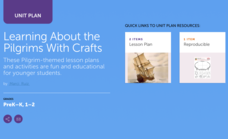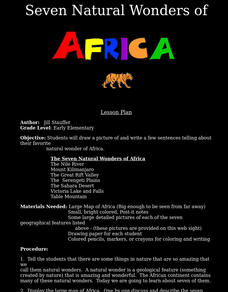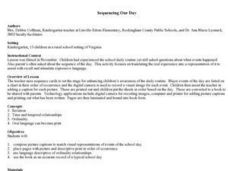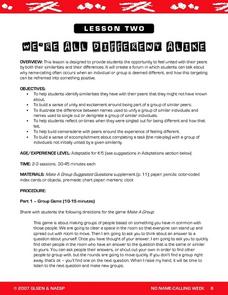Curated OER
Equator, North Pole, and South Pole
Students identify the Equator, North Pole, and South Pole on the globe. In this map skills lesson, students use a globe marker to locate specific locations on the globe. Students find where they live in relation to the Equator.
Curated OER
Using the Four Main Directions in the Classroom
Students use the four main directions to locate features in the classroom. In this direction lesson, students review the 4 main directions using a world map. Students use a magnetic compass to locate the north wall in their classroom and...
Curated OER
Dalai Lama Tibetan Mandala Lesson
Students read a story from Tibet and discuss making choices in our lives. They explore the culture of Tibet and its traditions. In groups, students work cooperatively to construct a depiction of a Tibetan mandala.
Curated OER
Online —On Stage—and Action
Use your tablets to participate in a culture-sharing project with a class in a foreign country. Your class can communicate and share ideas with a class in another country, swapping information regarding language and culture. Together you...
Curated OER
Bark Art
Students examine Aborigines, a group of people indigenous, or native, to Australia. They view examples of Aboriginal bark art and create pictures in the style of Aboriginal bark art.
Curated OER
KINDERGARTEN PEACE UNIT
Students learn the meaning of peace, the value of world peace and the individual commitment it requires through discussion and a variety of hands-on activities
Curated OER
Growing on My Own, Kids on the Grow
Students participate in an after school program that promotes critical thinking, concern for others, recognizing differences, accepting differences, self-motivation and personal safety. They cover how kids develop, expressing different...
Curated OER
A Bird's Eye View Of Your Community
Learners locate and identify their community by using a satellite image from the Internet. Students locate and identify common land structures within their community. You may want to include structures such as roads/streets, houses and...
Curated OER
Safe or Not Safe
Students discuss the safety signs they viewed on their way to school before looking at safety signs at a website that presents a traffic safety school for students. They listen to a read aloud of Tana Hoban's, "I Read Signs," make signs,...
Curated OER
Everybody Celebrates
Examine the holidays of La Posada in Mexico, Hanukkah in Israel, and Kwanzaa in the United States. Learners identify the countries on a world map, listen to stories, create art projects for each holiday, and make recipes celebrating...
Curated OER
Trail of Tears
Students discover that the Indian Territory was comprised of many Indian tribes originating from many different locations. They distinguish between the Indian tribes in the Indian Territory.
Curated OER
Body Parts in Hebrew
Students, after practicing with an extensive vocabulary list of body parts in Hebrew, identify those parts on a poster of a human figure. They practice writing and saying their vocabulary words daily during class instruction.
Scholastic
Learning About the Pilgrims With Crafts
Students research the pilgrims in terms of why they left England, their voyage to America, the challenges they faced when they arrived, and their relationship with the American Indians. To conclude this unit, the students have a...
Curated OER
Freedom Summer
Young scholars brainstorm and discuss what the concept of "fairness" is and how to identify examples of "fairness." They pull from historical fiction and the Civil Rights Movement to explain how individual are affected by, cope with, and...
Curated OER
Clifford Learns About the Circus and So Do We!
Students investigate the characteristics of different circus jobs and the animals commonly seen at the circus. They read a book about clowns and construct and perform a trick hot dog. Students also create a clown accordion book.
Curated OER
Moving and Grooving with Tempo: Diversity of Learners Adaptation
Students with logical/mathematical intelligence keep count of the tempo of each song and of the number of different movements that they can create to go with the folk songs heard.
Curated OER
Winter Expressions
Students write a winter "shape poem," draw the outline of an object that complements the poem and copy the poem inside the outline in a pattern.
Curated OER
Seven Natural Wonders of Africa
Students draw a picture and write a few sentences telling about their favorite natural wonder of Africa. They discuss the importance of the Nile River, Mount Kilimanjaro, the Great Rift Valley, the Serengeti Plains, and the Sahara Desert.
Curated OER
Kameshi Ne Mpuku: An African Game
Students demonstrate an understanding that games reflect the environment of those who play them by creating their own games with the resources provided.
Curated OER
How Has Transportation Changed Since the 1899 Harriman Alaska Expedition?
Students recognize modes of transportation. They research historical data from a variety of primary and secondary sources including the Harriman expedition journals, related web sites, and photographs from the expedition. Students...
Curated OER
Mapping the Library
Learners compare their school library with another library such as: town library, for example, or a virtual library and identify the most important features. Students use their observations to create a map of the school library that can...
Curated OER
Sequencing Our Day
Students focus on translating the real experience of an ordinary day into a representation of it to assist with recall and stimulate expressive language. They compose picture captions to match visual representations of events of the...
Curated OER
We're all different alike?
Students identify similarities and differences that they have with their peers. They explore why name-calling often occurs when an individual or group is deemed different, and how this targeting can be reframed into something positive
Curated OER
Native American Dolls
Students examine Native American dolls. They discover the connections between the dolls and the Native American culture and customs. They also use maps to locate the position of different tribes.
Other popular searches
- Esl Social Studies Lessons
- Social Studies Lessons Rome
- Social Studies Lessons Japan
- Social Studies Lessons on Maps























